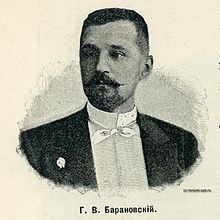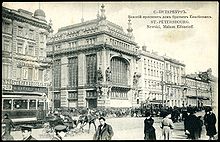Gavriil Wassiljewitsch Baranowski
Gawriil Wassiljewitsch Baranowski ( Russian: Гавриил Васильевич Барановский ), * March 25th jul. / April 6, 1860 greg. in Odessa ; † June 15, Jul. / June 28, 1920 greg. in Komarovo was a Russian architect, civil engineer, art historian and publisher. He mainly worked for the Jelissejew family in Saint Petersburg , but also in Moscow and created the town planning for Murmansk , then Romanow am Murman .
Life
Education and early career
Born in Odessa as the son of the lawyer Vasili Ivanovitš Baranowski and his wife Rosalia Malinovska Gawriil Baranowski, he received his training at the St. Petersburg Institute for Civil Engineers from 1881 to 1886. He completed his training with a silver medal of honor. He began his career as an architect between 1883 and 1885 as an assistant to Paul Susor (Pavel Susor). His first assignment was the government-funded palace of the main chancellery (Главная дворцовая канцелярия) from 1885 to 1888. Baranowsky worked on numerous apartment buildings in Saint Petersburg. After 1888 he was employed as an architect for the mechanical engineering and shipbuilding company Baltisches Werk .
Architect of Yelisseyev
Baranowski was married to the daughter of Grigory Jelissejew, from the Saint Petersburg branch of the merchant family Jelissejew. His wife's family owned several properties in Saint Petersburg. Grigory Jelissejew's house was the first building that Baranowski designed and executed as chief architect from 1889 to 1890 . He then planned several country houses for the Jelissejew family and the Jelissejew delicatessen store on Nevsky Prospect , which was built between 1900 and 1903 , as well as its counterpart in Moscow, on Tverskaya Street , together with Marian Peretyatkovich . In 1898 Baranowski became the site manager for all properties belonging to the Jelissejew family. His style was shaped by shades of eclecticism , eventually he focused on Art Nouveau .
Public activities
In 1891 Baranowsky received an appointment to the office for non-profit corporations of Tsarina Maria and subsequently designed the St. Petersburg Eye Clinic. He also worked as a consultant for various government institutions. His public editorial work was more important, initially as editor-in-chief of Unser Haus (Наше Жилище, 1894–1895), which later became Stroitel magazine (Строитель, 1895 to 1905). His most important work was the promotion and processing of the "Architectural Lexicon of the Second Half of the 19th Century" ("Архитектурная энциклопедия второй половины XIX века") in seven volumes. It then became the most complete Russian reference for contemporary architecture.
According to St. Petersburg Fragments (Петербург - фрагменты), he died in 1920 of starvation caused by the Russian Revolution in 1917 and then the Russian Civil War . Baranowski's son Wassilij (d. 1945) emigrated to Sweden. He was a pianist and composer and made several recordings in his new home. He was married to the violinist Nora Duesberg .
buildings
Saint Petersburg and the surrounding area
- 1880s: Baltic factory , Saint Petersburg, 1880 as assistant to Ernest Gibert (1823–1909)
- 1885–1888: Chancellery on Vasilyevsky Island
- 1887: Bridge over the Smolenka , railway to the island of Dekabristov
- 1888: Jelissejew building extension, Birzhevaya Linia; 1900–1903 rebuilt later
- 1889–1890: Jelissejew apartment building, Fontanka
- 1889–1892: Yelissejew Apartment Building, Lomonosova Street. Repairs and expansion
- 1892: Grigory Jelissejew House, Birzhevaya Linia
- 1897–1898: Own rental apartment building, Dostoyevskogo Street
- 1899–1900: Princess Obolenskaya School for the Girls, Baskov Lane
- 1900–1903: Jelissejew deli (Saint Petersburg) , Nevsky Prospect; 1906 renovation of the adjacent buildings
- 1907–1909: Russian Geographical Society , Grivtsova Street
- 1908: Shuvalov Family House, Knyagininskaya Street
- 1909: Pawn Shop, Moika
- 1909–1910: House for Agvan Dorzhiev , Primorye Prospect 93
- 1909–1915: Buddhist temple, Primorye Prospect 91
Moscow
- 1899–1901: Jelissejew Moscow , Tverskaya Street 14 with Marian Peretyatkovich and Vladimir Voeykov
- 1905: Jelissejew Apartment Building, Kozitsky Lane, with Vladimir Voeykov
More buildings
- 1897–1899: Jelissejew Estate and Park, Toila-Oru , (destroyed)
- 1917: Urban planning for the construction of Romanow-na-Murmane (today Murmansk )
Individual evidence
- ↑ Елена Травина: Гавриил Васильевич Барановский, - кто Вы? (05/15/2013) . terijoki.spb.ru. Retrieved May 15, 2013.
literature
- Russian: Архитекторы-строители Петербурга-Петрограда начала XX века. Каталог выставки. Л., 1982; Барановский, с. 21-22 (Architects and builders of St. Petersburg and Petrograd at the beginning of 20th century. Exhibition catalog. Leningrad, 1982, pp. 21-22)
- Russian: Кириков Б.М., Федоров С.Г. Зодчий-энциклопедист (Г.В.Барановский). Ленинградская панорама, 1985, N 2 (BM Kirikov and SG Federov - Gavriil Baranovskii, Architect-Encyclopedist, Leningrad Panorama, No. 2, 1985)
- Russian: Нащокина, Мария, "Архитекторы московского модерна", М, "Жираф", 2005, с. 62-66 (Maria Naschokina, Architect of Moscow Moderne, M, 2005, pp. 63-66)
- Gabriel Baranowski: Världssubstanssen och dess härledning, sammanfattat och utgivet av Wassilij Baranowski, Lund 1921.
| personal data | |
|---|---|
| SURNAME | Baranowski, Gavriil Wassiljewitsch |
| ALTERNATIVE NAMES | Барановский, Гавриил Васильевич (Russian) |
| BRIEF DESCRIPTION | Russian architect, civil engineer, art historian and publisher |
| DATE OF BIRTH | April 6, 1860 |
| PLACE OF BIRTH | Odessa |
| DATE OF DEATH | June 28, 1920 |
| Place of death | Komarovo |





